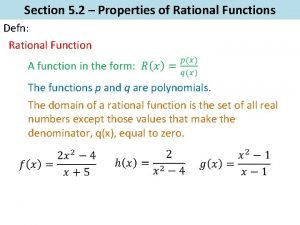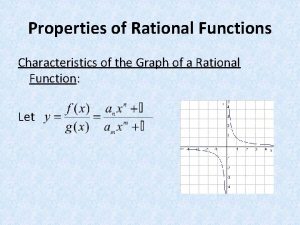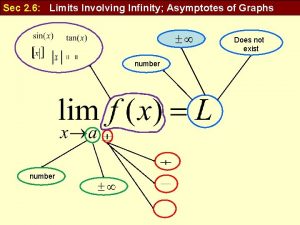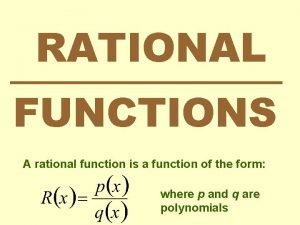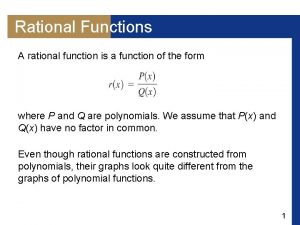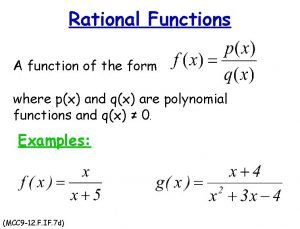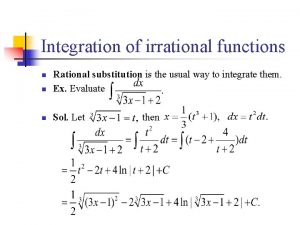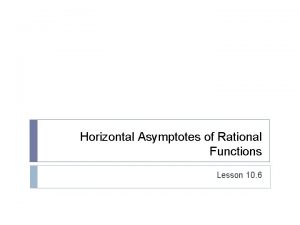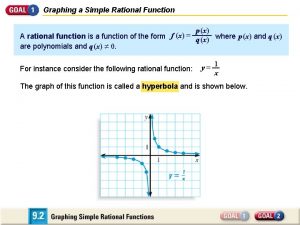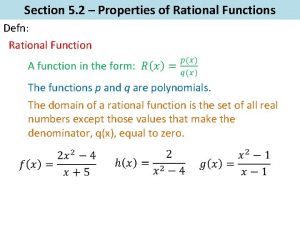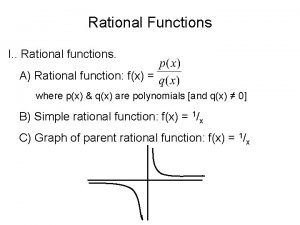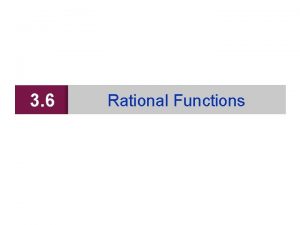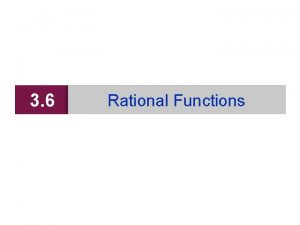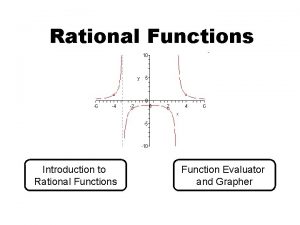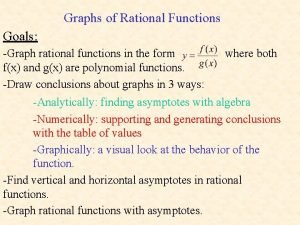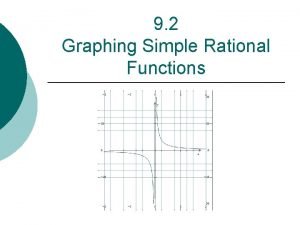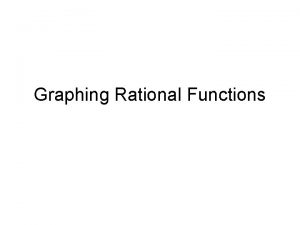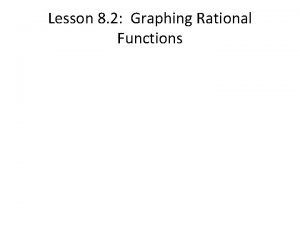Section 5 2 Properties of Rational Functions Defn




















- Slides: 20

Section 5. 2 – Properties of Rational Functions Defn: Rational Function The functions p and q are polynomials. The domain of a rational function is the set of all real numbers except those values that make the denominator, q(x), equal to zero.

Section 5. 2 – Properties of Rational Functions Domain of a Rational Function {x | x – 4} or (- , -4) (-4, )

graph

Section 5. 2 – Properties of Rational Functions Domain of a Rational Function {x | x 2} or (- , 2) (2, )

graph

Section 5. 2 – Properties of Rational Functions Domain of a Rational Function {x | x – 3, 3} or (- , -3) (-3, 3) (3, )

graph

Section 5. 2 – Properties of Rational Functions Domain of a Rational Function {x | x – 3, 5} or (- , -3) (-3, 5) (5, )

Section 5. 2 – Properties of Rational Functions Linear Asymptotes (vertical, horizontal, or oblique) Lines in which a graph of a function will approach. By approach we mean each successive value of X puts the graph closer to the asymptote than the previous value. Vertical Asymptote A vertical asymptote exists for any value of x that makes the denominator zero AND is not a value that makes the numerator zero, in this case the factors would cancel. Example A vertical asymptotes exists at x = -5.

graph

Section 5. 2 – Properties of Rational Functions Asymptotes Vertical Asymptote Example A vertical asymptote does not exist at x = 3 as it is a value that also makes the numerator zero. A hole exists in the graph at x = 3.

graph

Section 5. 2 – Properties of Rational Functions Asymptotes Horizontal Asymptote A horizontal asymptote exists if the largest exponents in the numerator and the denominator are equal, or if the largest exponent in the denominator is larger than the largest exponent in the numerator. If the largest exponent in the denominator is equal to the largest exponent in the numerator, then the horizontal asymptote is equal to the ratio of the coefficients.

Section 5. 2 – Properties of Rational Functions Asymptotes Horizontal Asymptote Example A horizontal asymptote exists at y = 5/2. A horizontal asymptote exists at y = 0.

graph

Section 5. 2 – Properties of Rational Functions Asymptotes Oblique (slant) Asymptote An oblique asymptote exists if the largest exponent in the numerator is one degree larger than the largest exponent in the denominator. **Note** Other non-linear asymptotes can exist for a rational function.

Section 5. 2 – Properties of Rational Functions Asymptotes Oblique Asymptote Example An oblique asymptote exists. Long division is required. We ignore the remainder if it exists

graph

Section 5. 2 – Properties of Rational Functions Asymptotes Oblique Asymptote Example An oblique asymptote exists. Long division is required. An oblique asymptote exists at y = 2 x

graph
 Rational function properties
Rational function properties What are the properties of rational functions
What are the properties of rational functions Solving rational equations and inequalities
Solving rational equations and inequalities Tux robot
Tux robot Whats a rational number
Whats a rational number Apply properties of rational exponents
Apply properties of rational exponents How is using exponents helpful
How is using exponents helpful Vertical asymptote
Vertical asymptote Rational functions parent function
Rational functions parent function Unit 8 rational functions homework 1
Unit 8 rational functions homework 1 Hyperbola parent function
Hyperbola parent function Rational expressions and functions
Rational expressions and functions Sec asymptotes
Sec asymptotes Horizontal asymptote of rational function
Horizontal asymptote of rational function Rational function examples with answers
Rational function examples with answers Rational function examples
Rational function examples Radical functions and rational exponents practice
Radical functions and rational exponents practice Lesson 3: rational functions and their graphs
Lesson 3: rational functions and their graphs How to graph irrational functions
How to graph irrational functions Rational functions holes and asymptotes
Rational functions holes and asymptotes Graphing rational numbers
Graphing rational numbers
